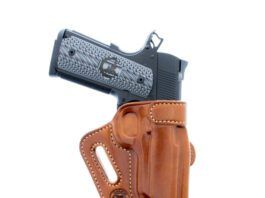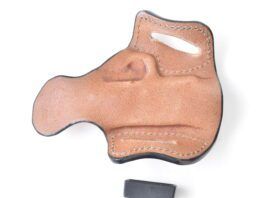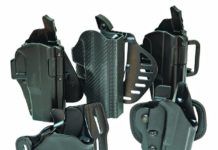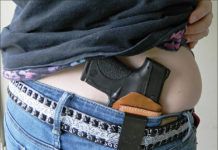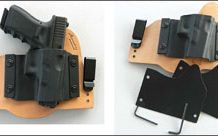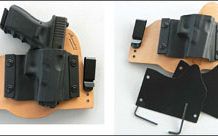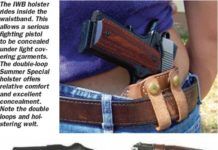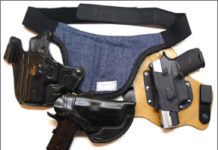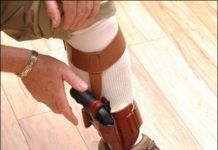Best Holsters for Handgun Retention, Part 1
Handgun retention is serious business for uniformed police officers who, as a matter of course, practice open carry. Special holsters with retention beyond a tight fit are mandated in most precincts, yet the list of police officers killed with their own guns sadly continues to grow. So what does this mean for civilians who openly carry their firearms? On January 1, 2016 the state of Texas will join the list of states no longer requiring concealed-handgun license holders to carry their weapons concealed. How many Texas CHL holders will immediately change their habits from stealth carry to out-in-the-open carry remains to be seen. Gun Tests doesn't get into how people carry and use their legally owned firearms, but we recognize that some legal gun owners will want to open carry, which creates two issues the shooter has to deal with in advance. Mainly, the gun owner must maintain control of a carry firearm while still having fast access to it.
Joe Woolley, president of Firearms Operations and Responsible Training of Texas (FortTexas.us), thinks the new law might prompt licensees to carry larger firearms that are ordinarily more difficult to conceal. But more important, he said, "The security level of any open-carry holster I use will need to be higher than for the concealed firearm." To see how manufacturers provide this extra security, we assembled a collection of 12 currently available holsters that supply more retention than most concealed models — that is, they require the manipulation of a locking device to draw the weapon. We'll cover this dozen in two parts in back-to-back issues.
Our test holsters were Hogue Incorporated's $50 ARS Stage One Carry, Galco's M4X and M6X each priced at $45, Blackhawk's $79 GripBreak, and the $32 Evader from Bianchi. In addition we tested three holsters from DeSantis, the $52 Facilitator, the $40 Quick Safe, and the $68 Prowler. We also tried a trio of holsters from Safariland, the $50 578 ProFit in Long and Standard sizes and Safariland's $50 6378 ALS. Last, we also tried Blade Tech's $124 WRS Level 3, which was much closer to being a police duty holster than what a civilian would typically wear. In this installment, we'll tackle the Blackhawk GripBreak, DeSantis Facilitator, Galco M4X and M6X, and the Hogue ARS C.
Most people think a tight fit in a typical holster constitutes Level I retention and the addition of a thumb-break strap makes it a Level II holster. That's not actually the case, any more than adding a mechanical locking device would change its rating to Level III. Retention ratings and their corresponding tests were originally developed by Bill Rogers, a former FBI agent and pioneer in modern police training. In purchasing the Rogers Holster Company in 1985, Safariland adopted his security rating system with tests intended to simulate a gun grab. Rogers' Retention Level I test (trademarked) "is described as applying all the force to the grip or handle of the weapon by an individual while the weapon is totally secured in the holster and mounted on a suitable belt being worn by another individual. The direction of force is unlimited, but the duration of the force is limited to 5 seconds. At the end of the 5 seconds, the weapon must still be secure in the holster and the holster must still be attached to the operator." By mounting each holster on a Blackhawk Instructor Gun Belt ($37 fromOpticsPlanet.com) we made sure any failure would be traced back to the holster and not to the belt.
Our tests likely exceeded Bill Rogers' protocol by wrestling to the ground for weapon control. We challenged retention using two types of grips, "educated" and "freestyle." The educated grip describes how an instructor might handle the gun, with the trigger finger held straight alongside the frame with three fingers wrapped below the trigger guard, thumb hugging the opposite side of the pistol. The freestyle grip started with all four fingers beneath the trigger guard and thumb wrapped around the other side. We also tried grabbing the gun with the left hand from a right-hand-side-mounted holster. In the interest of security, we're not going to tell you everything we learned about drawing from these high-retention holsters — just whether or not they might help protect you from a gun grab.
Hot-Weather Carry: Talon IWB, Ted Blocker S18 Are Best Buys
Shoulder Holsters: We Test Four Pricey Rigs Head to Head
When it comes to handgun concealment, perhaps the most colorful configuration is the shoulder holster. Shoulder holsters are not as popular in the real world as they are in old detective movies, but that has as much to do with contemporary style as it does with the cost of a good rig, especially when compared to a Kydex belt holster. People simply do not wear sport coats as much as they used to. But shoulder holsters do provide superior access when seated at a desk or behind the wheel of a car.
To learn more about shoulder holsters, we purchased four different models from the company that offers more designs than any other maker. Galco International (USGalco.com) began making gun leather in the late 1960s as the Famous Jackass Leather Company in Chicago, Illinois. Their most famous product was a shoulder holster referred to as the Jackass Rig worn by Don Johnson in the second season of the 1980s hit show Miami Vice. Later, Johnson's character, Detective James "Sonny" Crockett, was fit with a new model from Galco, the Miami Classic. It was covered by a summer-weight sport jacket and sparked a trend in men's fashion that some of us would like to forget.
To carry our full-size Springfield Armory 1911 45, we chose the $200 VHS vertical carry shoulder system with a vertical drop dual magazine pouch. To house our Springfield Armory XDM 3.8 9mm compact, we picked the $195 Miami Classic II with dual magazine pouch, offering horizontal open top access. For our Caspian 1911 Commander we bought a $165 Jackass Rig, also with a vertical drop dual magazine pouch. This design offered abbreviated coverage of the pistol's top end but greater diagonal adjustment for the holster than the Miami Classic. For our Sig Sauer P239 we tested a $93 Classic Lite shoulder system with single vertical drop magazine pouch fashioned from center cut steer hide with a natural finish. The Classic Lite is the least expensive shoulder system that Galco makes.
Belt Slide Holsters – A Viable Choice For Concealed Carry?
The belt-slide holster design is basically a sleeve of material through which the carrier pushes the muzzle of the handgun, leaving the nose of the sidearm and the grip uncovered and the middle of the gun secured by the sleeve, aka the slide. Many criticize the design because it doesn't protect the muzzle or front sight, the gun can be pushed up when the user sits, the gun can be noisy when it hits against chairs or other hard objects, and the carry arm can be unsecure if the slide isn't snug on the frame and slide.
Despite these worries, belt-slide holsters are among the most popular holster types. Some view them as convenient for range use and carrying the handgun to the range and back and little more. Others feel that the belt-slide holster is a good choice for concealed carry. As is often the case, the rule is that the belt slide only works if you use a good example. The thin suede-leather or fabric types just do not make the grade except for range use and even then, they do not properly present the handgun for any type of draw angle. The draw angle is derived from the necessary gap between the handle of the handgun and holster and the torso as well. The handle of the handgun must be presented in such as way that the hand may grasp the grip and draw into the target. If the holster does not allow a fast presentation, then the handgun must be partially drawn with the fingertips to facilitate a draw. This is slow and fumble prone.
The belt slide was once almost universal among trainers, as they found it an excellent holster for general range use. They ended up using it for concealment under a light shirt or vest. There are a number of impressions of the belt slide that are not always accurate. It has been noted that the belt slide may be worn without the gun and it doesn't look like a holster. We fail to see the advantage of wearing a holster without a gun, recognized or not, but rather see a disadvantage. If anyone does recognize the belt slide as a holster, then they will quickly realize you are not armed. The better type of belt-slide holster is clearly molded to the outline of a gun. It is unmistakably a holster, not a tobacco pouch.
As noted above, a persistent criticism of the belt slide is that with the muzzle and much of the slide exposed, the handgun may be levered out of the holster if the muzzle contacts a chair when the user sits. If any holster meets the edge of the chair, the holster will be levered up against the body. If a long-barrel handgun is used in a belt slide, there is some chance of the gun being pushed up, but it depends upon the retention involved. The handgun may be levered out if the handle meets the chair as well as the muzzle meeting the chair. You really need to be aware you are wearing a gun!
As for the balance of speed and retention, the speed of the type cannot be disputed; it was the retention that worried us. The belt-slide holsters tested proved to be very fast on the draw. The better examples featured good retention for a minimum of leather. For use under a light jacket with a short-barrel handgun, these holsters have merit. The problem of positioning the handle away from the body to allow a good sharp draw is solved to an extent by some of the holsters, and the draw angle makes for good speed in others.
Gun Tests recently compared several of belt-slide designs to assess whether they are secure enough for us to recommend for everyday carry, and whether their minimalist form offers any advantages in comfort over other styles. We consider them piece by piece below:
Inside-The-Waistband Holsters: Kydex, Leather, & Hybrid Styles
Inside-The-Waistband Holsters: Kydex, Leather, & Hybrid Styles
Leather IWB Holsters: We Say LCLs Savannah Is a Best Buy
Multi-Use Holsters: Can One Leather Choice Do Two Jobs?
Here at Gun Tests we do not often address intangibles. We measure performance in a logical manner. We test firearms, devices, and ammunition in a repeatable and verifiable manner. We do so in order to produce a level playing field for products. This is a credible standard for comparison. Just the same, sometimes a concept is worth a hard look. This month we are addressing the concept and execution of holsters that are designed to fill more than one mission. We have explored the concept and found that, at least in the case of some of the holsters tested, the concept is viable.
We wondered, is it possible to have a holster that fulfills several different jobs. Or would we find the truth of the adage, "jack of all trades—and master of none," and learn that a certain holster style is suited only to a single style of deployment? There have been numerous multi-function holsters advertised to fill more than one mission. We chose to cover six holsters that have been advertised as multiple-role holsters. These range from more-or-less standard holsters with extra belt loops to a holster with multi-directional belt loops.
But inquisitive GT readers (you know who you are) will challenge: Why compromise at all? Why not simply choose a single holster for each mission? Realistically, who wants to have to swap rigs to move from car to office to restaurant, especially for those of us living in a true four-season climate? If one holster can work inside the waistband (IWB) for concealment, as a strong-side belt scabbard offering real speed and comfort, and as a cross-draw holster for those who are seated or driving most of the day, that would indeed be a valuable piece of kit. Also, with quality custom leather and Kydex holsters approaching $100 dollars or more, it is important that we make a good choice.
Our test products were the Ted Blocker X 16, $97; Tauris Double Shift, $160; K&D Holsters' Thunderbird Defender, $95; Raven Concealment Systems Phantom, $90 (which includes an optional $20 loop kit); Simply Rugged Tribute, $95; (which includes $10 for IWB loops); and the Classic Old West Styles Four Way Holster, $38.
To start, we examined these units with an eye toward assessing the use of good materials, professional surface finish, and tight, durable stitching. How well the holsters function in the field is another matter, so we tested these holsters on the body extensively. Several team members wore a rig for at least a week each, then traded off holsters to various raters. We also drew handguns from them and shot targets at a range.
In particular, we focused on cant and rake during our field and shooting assessments. Cant is the angle of the holster away from the body. Rake is the angle of the muzzle. If the muzzle is pointed to the rear or spine of the holster, it's is a "rear rake" design. Almost all holsters are a rear rake design. A very few are a neutral cant, useful for the most part with compact handguns. The forward rake holster is most often seen as a competition holster for very tall shooters. A forward rake would expose the butt to printing on the garments and would be unsuitable in a concealed-carry holster.
At the end of the field and range work, we compiled the tester's pro-and-con comments during a roundtable discussion. To avoid a lackluster "jack of all trades, master of none" nomination, the holsters had to receive an A grade in one of their design missions and at least a B grade in the second. In other words, a strong-side holster that could be carried as an IWB needed an A grade as a strong side and a B grade as an IWB to pass.



























